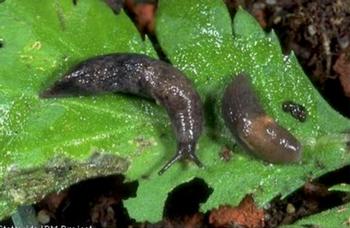Snails and Slugs
-
AboutBoth snails and slugs are members of the mollusk phylum and are similar in structure and biology, except that slugs lack the snail's external spiral shell. These mollusks move by gliding along on a muscular “foot.” This muscle constantly secretes mucus, which facilitates their movement and later dries to form the silvery slime trail that signals the recent presence of either pest.
 Photo: UCCE Sutter-Yuba
Photo: UCCE Sutter-Yuba -
CategoryMollusks
-
Signs/Symptoms
Snails and slugs feed on a variety of living plants and on decaying plant matter. They create irregular holes with smooth edges on leaves and flowers by scraping with their rasp-like tongues. Small succulent plant parts are easily clipped by snail and slug feeding. They are also serious pests of turfgrass seedlings and ripening fruits that are close to the ground, such as strawberries and tomatoes. Snails and slugs will also feed on the young plant bark and foliage and fruit of some trees. Citrus are especially susceptible to damage.
Other pests can cause holes in leaves, flowers, and fruit. Look for the shiny slime trails slugs and snails leave behind.
-
Where
On sunny days, they seek hiding places out of the heat and bright light. Often the only clues to their presence are their silvery trails and plant damage.
During cold weather, snails and slugs hibernate in the topsoil. During hot, dry periods snails estivate (hibernation during hot weather) by sealing themselves off with a parchment-like membrane. They often attach themselves to tree trunks, fences, or walls.
-
When
Snails and slugs are most active at night and on cloudy or foggy days. Go out at night or in the early morning to view them in action.
-
Prevent
Remove daytime hiding places such as ivy, weedy areas, debris, and boards.
Place your garden in the sunniest spot possible. Remove garden objects, plants, or ground cover that can serve as shady shelter.
Reduce moist surfaces by switching to drip irrigation or by running sprinklers in the morning rather than later in the day.
Make sure the garden is mollusk-free before planting, then erect a copper barrier around it. Use a four to six inch wide band of copper, buried an inch below the soil and bent over at the top or attached around the edge of a raised bed.
Consider snail-proof plants such as impatiens, geraniums, lantana, nasturtiums, and other plants with stiff leaves and highly scented foliage such as sage, rosemary, and lavender.
-
Manage
Eliminate, as much as possible, all places where they can hide during the day. Boards, stones, debris, weedy areas around tree trunks, leafy branches growing close to the ground, and dense ground covers, such as ivy, are ideal sheltering spots.
Regularly remove snails from shelters such as fence ledges, undersides of decks, and meter boxes.
Build a trap using a board raised off the ground by one inch runners. As mollusks collect under the board, scrape them off and destroy daily.
Place beer traps in your garden and dispose of trapped snails and slugs daily.
Pesticide baits will not be very effective unless you also remove shelter, food, and moisture.
Iron phosphate baits are safe for use around dogs, children, and wildlife.
Ferric sodium EDTA is a newer active ingredient that works like iron phosphate. This product is not organically acceptable.
Metaldehyde baits are especially poisonous to dogs and birds. Metaldehyde also loses its effectiveness rapidly in sunlight and after rain or irrigation.
Irrigate before applying bait and apply in the evening on warm days when mollusks are active.
Scatter, don't pile, bait around sprinklers and in moist, protected areas where mollusks travel. Always read pesticide labels before applying the product.
-
More Information
Snails and slugs have many natural enemies, including ground beetles, rats, pathogens, snakes, toads, turtles, and both domestic and wild birds. Most are rarely effective enough to provide satisfactory control in the garden.

